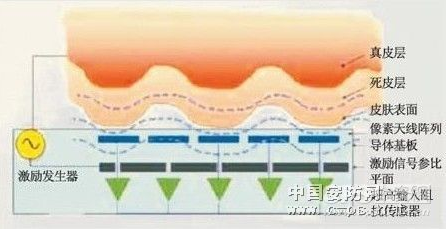-
Fingerprint identification in vivo
2018-05-05
SummaryFingerprint refers to the uneven skin on the end of the human finger. This pattern contains a lot of feature information, and the pattern, breakpoint and cross point of different human finger patterns are different, that is, the human fingerprint is unique and invariable. Depending on the uniqueness of the fingerprint features, a person can correspond to its fingerprint. By comparing his fingerprint features and the pre - preserved fingerprint features, the real identity of the fingerprint can be verified, that is, the usual fingerprint recognition. In vivo fingerprint identification is to use the fingerprint sensor with higher resolution, to detect the dermis of the finger and to identify and authenticate the fingerprints. The object of recognition must be the finger of the living person. This technology has good applicability for dry, wet and rough fingers.
Technical principleThe fingerprint identification is based on the fingerprint, and the real fingerprint is formed in the dermis. The fingerprint information of the true skin is clearer and more accurate than the skin, and it does not change with the age. The first generation of optical fingerprint identification is only the texture information of the skin of the fingerprints. This skin fingerprint will grow as the age grows. Blur. In vivo fingerprint identification detected the dermis of the finger, using a number of technical metrics, such as continuous and effective fingerprint data, relative temperature and humidity, to ensure the identification of the living body.
 Technical process
Technical processThe identification of living fingerprint recognition is accomplished by 4 processes: the collection of the living fingerprint image, the feature extraction of the fingerprint, the preservation of the feature data and the matching and matching of the eigenvalues. First, the fingerprint of human body is collected through the living fingerprint collection instrument. After the fingerprint image is taken, the original image is processed preliminarily to make it clearer. Then, fingerprint identification software is used to establish the digital representation of fingerprint -- characteristic data. This is a single direction transformation that can be converted from fingerprint to feature data and can not be converted from feature data to fingerprints, and two different fingerprints do not produce the same feature data. The identification software finds the data points called "nodes" from the fingerprint, that is, the fork position, the termination or the coordinate location of the loops. These points have more than 7 unique characteristics at the same time. Usually the average finger has 70 nodes, so this method produces about 490 data. Some algorithms combine nodes and direction information to produce more data, which are usually referred to as templates, and are saved as 1K size records. However, there is still no template standard and no abstract algorithm. Finally, through the method of computer fuzzy comparison, the two fingerprint templates are compared, and their similarity degree is calculated. Finally, the matching results of two fingerprints are obtained.
Technical advantageThe basic difference between the non living fingerprint identification and the living fingerprint identification is that the non living fingerprint identification is mainly to identify and authenticate the skin layer of the finger, while the living fingerprint identification is the needle for the dermis of the finger, which can effectively eliminate the "false fingerprint", and has a good applicability and improvement to the dry finger finger. The accuracy of fingerprint identification.


